So what's the deal? I don't know what the advatages are. Is more user friendly? Can you post huge MP3 files on that thing without routing to hidden webhosting service? Becuse that would be awfully nice. Or is it just what all the cool kids are doing. I'n not knocking that, I would like to be cool someday too.
(EDIT- Holy crap, all the cool kids are doing it, it say so right on their own page)
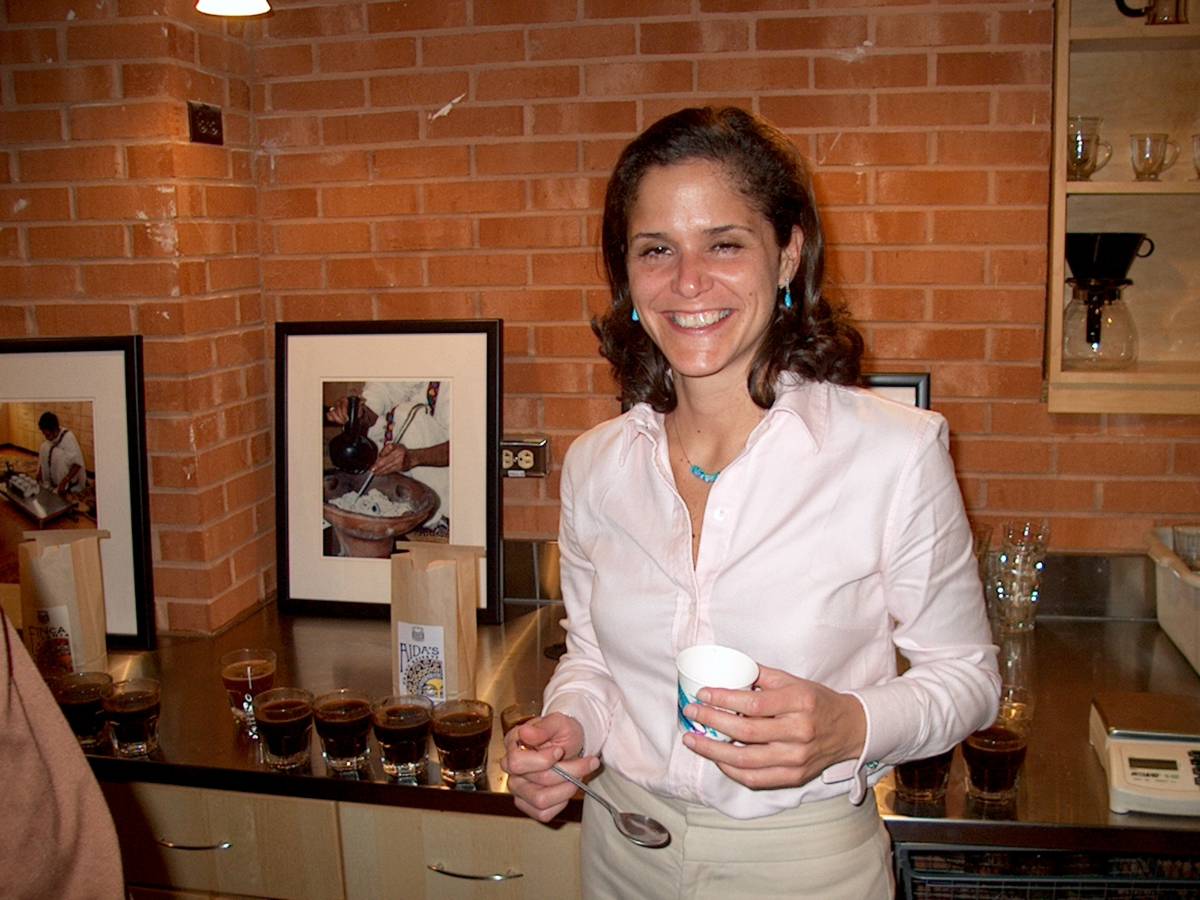
The reception held for Aida Batlle last night at Counter Culture Coffee in Durham, N.C. Was a small intimate affair with about 20 people in attendance. I knew that she was in town because I read that she had made a stop at Pheasant Creek. Then, a few days ago, I received very short notice that would make a surprise visit to the shop where I work on Friday nights, but it was too short and I could not be there. I was delighted to find that a 12 oz bag of her Grand Reserve had been left behind, but more on that later. The relief I felt when I found out about the reception, and found out that I had a babysitter for the evening, was a great satisfaction.
My wife and I arrived to find a few people milling about the training and cupping room. This is wing of the CCC building that is roughly 700-900 square feet outfitted with a GB-5, FB-70, a towering Robur grinder, a Mahlkonig Guatemala grinder, an assortment of smaller Mazzers (I think that is the make) and their newest addition; the LaMarzzoco Swift. There are several tables, glasses, spoons, scales, and of course, the cupping grease board. Standing by the door was Peter Giuliano, pouring himself a cupping glass of red wine. I received bottled water, also in a cupping glass. That was all they had, cupping glasses.
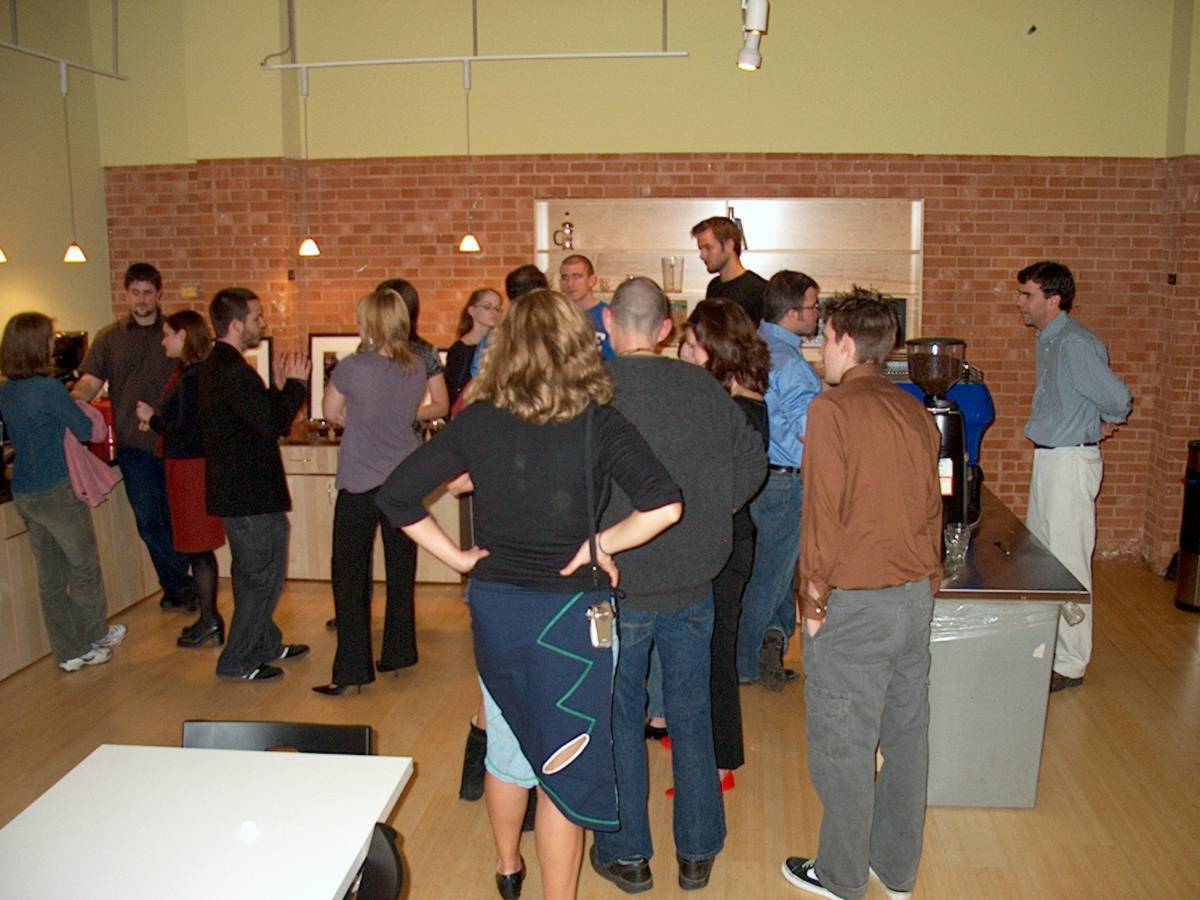
There was a fantastic buffet of food (I don't know who catered) that included shrimp, crab cakes, sesame beef on a stick, and some crescent shaped stuffed and fried Indian things, the name of which I do not know. It seemed a little thin for the vegetarians, except for the Indian crescents, but I was told Gee was out of town, and he would be the only one to complain if he were present (I always imagined him eating ½ inch thick, red, runny, rare steak. You just never know). Every thing was delicious.
After everyone got their fill Peter Giuliano began to introduce Aida Batlle by prefacing that her humility and modesty prevented her from telling people about the CoE's that her coffees started winning immediately after she took over her father's coffee farms (her family has farmed coffee for 5 generations). The first year she entered samples, (around 2002, I forget the exact year) she broke a number of records: the first female farmer to win, the first to have two samples in the top 20, the first El Salvador to take first place. Peter listed some others that escape me.
After being praised for long enough, she began her slide show presentation. She spoke of how she went back to El Salvador, her country of origin (no pun), after having lived in the U.S.A., and having no coffee back ground herself. The farms were in bad shape as a result of pushing the trees to overproduce for so many years, only to fetch low mass market prices. In addition to the low monetary earnings, the shade grown trees had not been taken care of properly as all the efforts went into pushing the trees. Activities such as stumping (cutting trees back to 2 foot stumps to create new low growth), breeding, nursery growing, and proper pruning had not been done for a long time. Even though she had no direct knowledge of the coffee growing business, Aida said she understood very well that growing for quantity was sure to sacrifice quality, and she began to turn around the farming practices they used at the three farms she was now managing; Los Alpes, Finca Kilimanjaro, and Finca Mauritania. The farms are producing far less than they did in years past, but she now produces coffees
on par with some of the best coffees in the world. The peaberries that make up the Grand Reserve, which were selected from the best crops of each of the three farms, sold this year for 20 American dollars per pound, green. She admitted that she would have been perfectly happy (and only expected) to get $3.00 for it. She was going to auction a third of the micro lot among three American buyers, but then the buyers just offered her the $20 per lb. (under the suggestion of Peter Giuliano) and split the lot between them. She sold another third to buyer in Japan, and the last to a buyer in Norway. So you will have to go a long ways to find this coffee anywhere else in the world. And to think that just two years ago other coffee farmers were telling here she would not be able to give away peaberries, since there is no market for them (in El Salvador they are considered a defect, an aberration, a useless mutation) That is exactly what she did; she gave away her peaberries. I think she stated that her intention was to try to create a market where she perceived there was none.
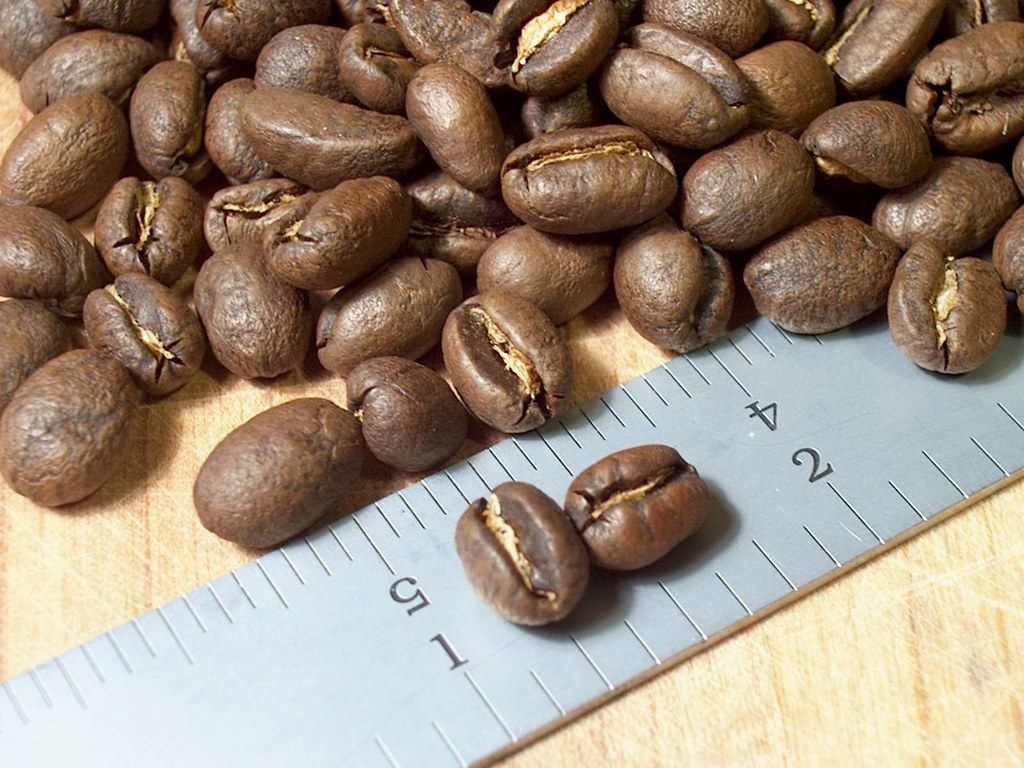
When the presentation was over, there were a couple of Q & A's about some farming practices, and it turns out that changing over to organic practices has been an extremely expensive shift. The organic pesticides cost something in the neighborhood of 5 times more than the commercial products, and she started to buy organic chicken dung and manure, which is also very costly. The time spent on pruning and raising new saplings and taking care of the shade trees is much more exhaustive than the techniques of the late 20th century. But her inspection for her organic farming certification was just last month, in October of 2006, and she seemed confident about the results, which she will be getting back soon.
Then came the good stuff. Beans were weighed, water was boiled, spoons and spit cups were passed out to all who wished to partake in a traditional cupping. There were also several press pots plunged for those who wanted to sample the goods in a more “after dinner” style. Three of her coffees were presented in the cupping: Finca Mauritania, Grand Reserve, and a third which had no label or writing on the bag. I heard what it was called in passing but I don't remember now. They said they did not have a label made for it yet, but that Murky had made their own label for it. So if you are in the D.C. area, ask about Aida's “other” coffee. I got a whiff of Brandy fragrance, and it had a sweet flavor that made me think of raisins and dried figs. It also had a clear acidity and a marvelous velvety body.
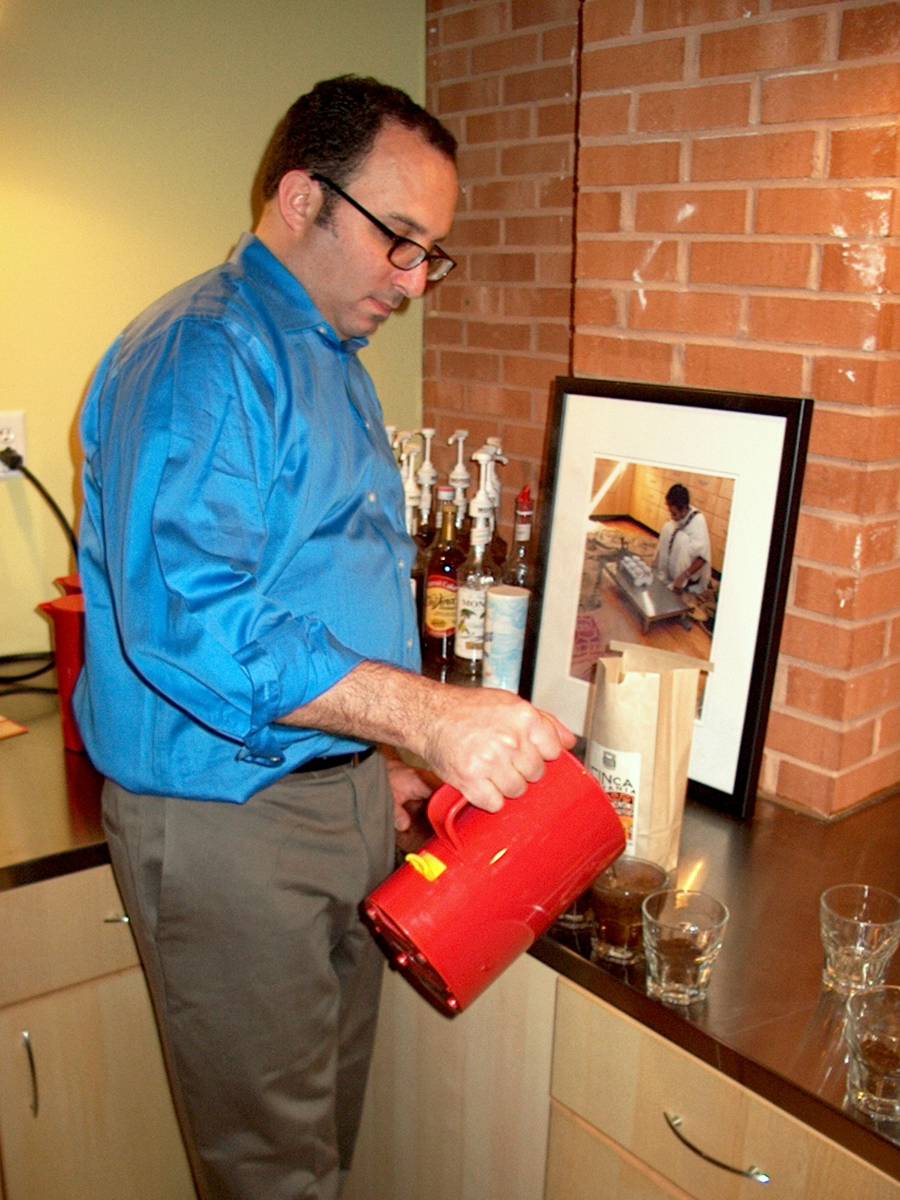
I will let you find some Mauritania for yourself, but this entry would be incomplete without a run down of the Grand Reserve. The moment the hot water hit the grounds I caught a distinct fragrance of apricots. This happened on three different occasions (I have been drinking the stuff since Thanksgiving day). There was also and sweet brown sugar smell, and hint of lemon. I forgot to mention, the beans smell like candy in the bag. One CCC employee, Rich Futrell, described it to me as peanut butter cups before I mentioned the candy thing to him (a little validation goes a long way in such subjective efforts). I have had both medium and thick body sensations from different cuppings, and when it was thick it was fantastically rich. If you get a hold of some of this stuff try it with a long steep time, and despite the temptation to be stingy with such pricey coffee, make sure you are at the top of your ounces to water ratio. It will be well worth it.
The acidity of this coffee was astonishing to me in that it was unlike any I have previously experienced. It is no stretch to say I perceived a good deal of tart nectarine and sweet Mandarin orange. Like the sweet tart candies, it has that magical Yin Yang balance. This is an all around stellar coffee, and because of the extremely limited supply (I think 500 lbs in the whole world) it is wroth the $45 per 12 oz. bag.
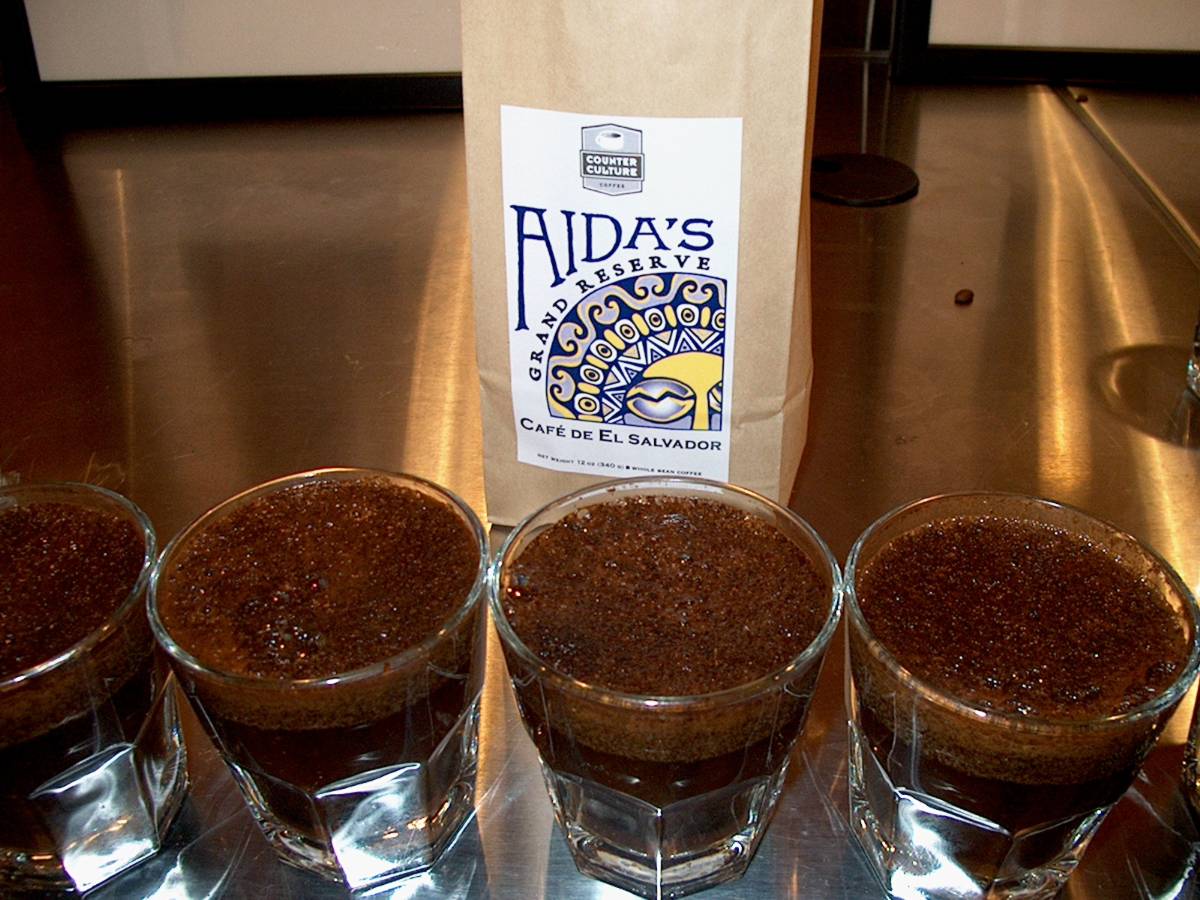
The closeness I feel to this coffee, after meeting with the farmer and seeing photos of the people who pick and sort it by hand increased my appreciation for it all that much more. I'm really going to be working hard to increase the knowledge base of our customers to reel them into understanding these kinds of coffees, their scarcity and their value. Casual coffee drinkers could have their coffee drinking experience so much more enriched with the proper education. I have been talking to customers one at a time about these kinds of coffees, and even let one sample the Grand Reserve. I had him scared to spill a drop of it on the way to his table, and he loved it and appreciated it down to the dust at the bottom of his cup. Aida showed me how little I know and understand about the cultivation of coffee. There is so much work and sweat and manure and miles and lives and stainless steel between the farm and table, I doubt if anyone has more than a window of understanding into the whole journey of the bean from proverbial seed, to proverbial cup.
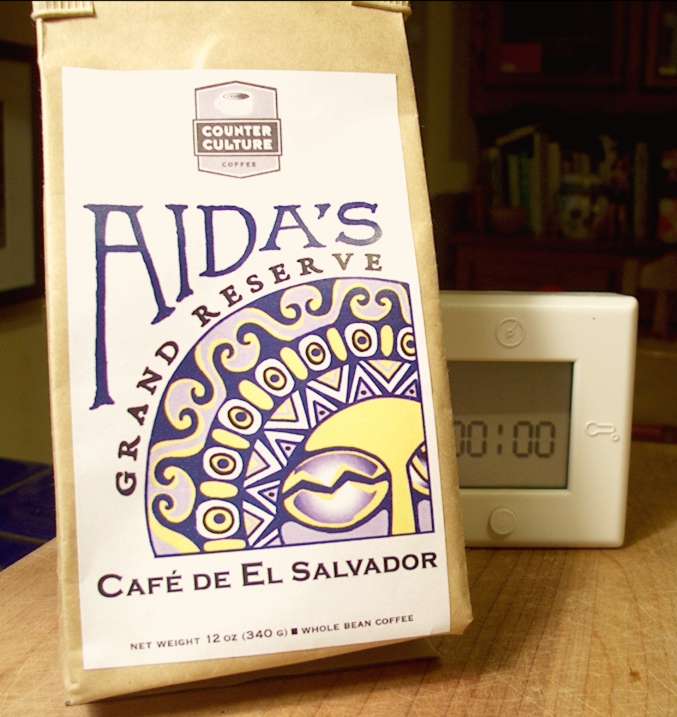
I thought I let her slip through my hands, I had not sampled it when I had the opportunity. Then, out of nowhere, a sample showed up. Plus, I will be meeting Aida Battle this weekend at CCC.
Apricots, Nectarines, and Mandarin Oranges.

The mission: To train all the Baristas of an established coffee shop, and the G.M too.
The complication: Six of the Baristas, with experience ranging from 3 years to 3 months, have been working on all the equipment, having been trained in the "sink or swim", learn-through-osmosis tradition. The other 3 are new, thankfully, and will be the proverbial blank slate.
The problem with re-training Baristas who believe they have already been trained is that they believe they have already been trained. The ones that have been there the longest also believe that they know what's what, and have seniority. Salt is added to the injury in the fact that I have only been working at this shop for 7 months, and I only work on Friday nights. I try, however, to keep my mind open to knew knowledge and techniques. If something comes along that improves freshness, quality, increases public education, or in some way advances the industry, I would like to think that I will check it our and verify for myself before either incorporating it into my mental model, or writing it off. The average PBTC, I have noticed over the years, will accept certain things as truth from the beginning without having any understanding of why it is the truth. This can and does lead to a wide variety of myths and fallacies passed on from one Barista to the next. Let me illustrate with a "humorous anecdote".
Mama Jones teaches her daughter (son) how to prepare the Christmas (Passover) ham (Matzah balls, or ham, like my Jewish vegetarian friend Jonathan). Little Debbie (insert non insulting yet ethnic sounding name of either gender here) asked her mom why she has to cut three inches of ham off the end, and she says:
"My Momma always made it like that".
In a puzzled state of confusion, they called Grandma Jones to ask why, and her response was,
"My Momma always made it like that".
This was no better, so they called Great Grandma Jones to ask her.
"Great Grandma" they questioned, "why do you cut off the last three inches of ham?"
Her answer was simply this:
"I could never afford a lager pan, I cut off the part that didn't fit".
Baristas who are not given an understanding of why they need to perform certain procedures a certain way can and will propagate a habit to other Baristas without explanation. It seems that there are only a handful of Baristas who have the wherewithal to ask why. I have noticed that some will give reasons that make no logical sense, but that is what they have been told by others. I have also noticed that some Baristas will deliberately make up reasons because they have a hidden agenda, and they want things done their way for their own reasons.
It is a delicate task to cut and paste new information into an existing set of mores. One cannot expect to rush in and proclaim ultimate control of all procedures. New ways of doing things will be balked at. In cases where it is more convenient for the Barista to do the less fresh, lower quality procedure, there will be turbulence. The funny thing is, they will blame the customers buy saying if it takes longer to do something the customers will complain and become impatient. I wonder if they will be able to see the flaw in the philosophy of convenience before quality.
"If you can wait one minute, I'll have a perfectly fresh cup for you, thanks."
vs.
"I knew you would be in a hurry, so I had the closing staff grind all the coffee last night, it's all stale, but I'm saving you 30 seconds of your valuable morning."
It is true that specialty coffee shops are held in a dualistically oxymoronic view by the general public. We are supposed to provide them with a gourmet product of the highest quality. They expect a certain level of culinary achievement and an atmosphere of culture, all with the efficiency of the MacDonald's drive through window. At least once every Friday night I hear a customer plead with me for their drink while I am delivering someone else’s beverage to the counter.
"Excuse me, I had ordered the triple pumpkin spice skinny mocha."
I check my list of tickets, and sure enough, it will be one of the next two drinks to make. The problem is that they ordered the drink four minutes ago, and it is not ready yet. They automatically assume I lost the ticket. So there is a two fold educational journey upon which I must embark. The Baristas need to learn how to draw the best shots and build the best drinks without compromise. The customers must be brought into the fold and made to understand the caliber of beverage they are receiving. It is an entierly different thing to teach someone how to spark the imagination of a customer. There is a certain "je ne sais quoi" in the way one can talk about coffee to a customer that conveys a sense of passion and enthusiasm and love for the product. The ability to pull someone into the vortex, and grab them by the buds, is perhaps more of a chracteristic than a skill.
I don't expect everyone to be trouble, but I know there will be some problem areas. I fact, I know some of them are excited about getting things going towards a higher quality of product. The training process will go on for months just the get everybody in the shop up to snuff. By then someone will have gone back to school, taken another job, moved out of town. Then the knowledge will be passed on to someone new. I don't mind, I asked for this.
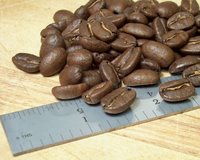

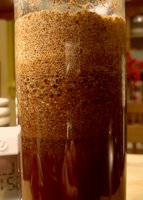
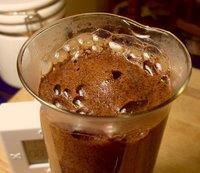
I don't know much about this Papua New Guinea, the "Red Mountain". It just came into the shop today for the first time. The roasting would have been done just yesterday, and the ridiculous amount of gas it gave off would seem to support that. As soon as the hot water hit the inside of the beaker the grounds puffed up bigger than any coffee I have ever seen. The crust expanded and put out large bubbles like a seventh grade vinegar and baking soada volcano. I had to wait a minute just to add the rest of the water, after the grounds settled back down a bit.
There was a sweetness to the aroma that it was giving off that put me very much in mind of red velvet cake, if you know what that is. It's really just chocolate cake with enough red food coloring in it to wipe out half the cactus population in Mexico. But then I thought, just because they call it "Red" Mountain does not mean I have to envision red things in the flavor, does it? Then I came to my senses, it was caramel. It smelled like a dark molases enhanced caramel. For some reason, I always think of bread when I smell the coffee crust, but this another story; sweet caramel.
After plunging and pouring, I noticed that there was not the amount of oily residue floating on top, at least not as much as I expect from a plunged brew. There was, however, a very persistant foam that took a good 6-8 minutes to dissapate. I wish crema was as tenacious. Hmm, maybe this would be good in espresso, carmel, crema, try it out folks and see what you get.
The body seemed medium to thin, but not in a negative way. It was very much in balance with the very pleasant acidity which was lightly giving off a little grapefruit/tangerine, very lightly. A slight buttery mouthfeel complemented the the balanced acid/body very well too; the trifecta of tactile.
At this point I could swear my mouth was begining to warm up a bit, the way it would with spice. Not woody spice like cloves or nutmeg, but like red peppers? No, it seemed not quite that intense, ginger I think. Not the flavor of the ginger, but the heat of it.
One of the really pleasant things about this coffe was the way the aftertaste came on as a kind of sweentness, and then sharply trailed off to a mild hint, a shadow of the beautifully balanced appeal it had in the begining. The acidity became more prominent as it cooled off, which gave it a crispness that was just approaching the cusp of some African coffees, but still held on to its clean Indonesian roots.
This was an excellent coffee that would go very well as an after dinner beverage, rounding off a filling a thick textured meal. But I get the feeling you would need a vanilla dessert, not chocolate. So if you are into coffe and food pairings, that would be my recomendation.
(edit: I just realized that apparently Daniel Humphries and Daryn Berlyn are also thinking of drawing straight shots of this stuff, follow the same link in "get to know your roasters")
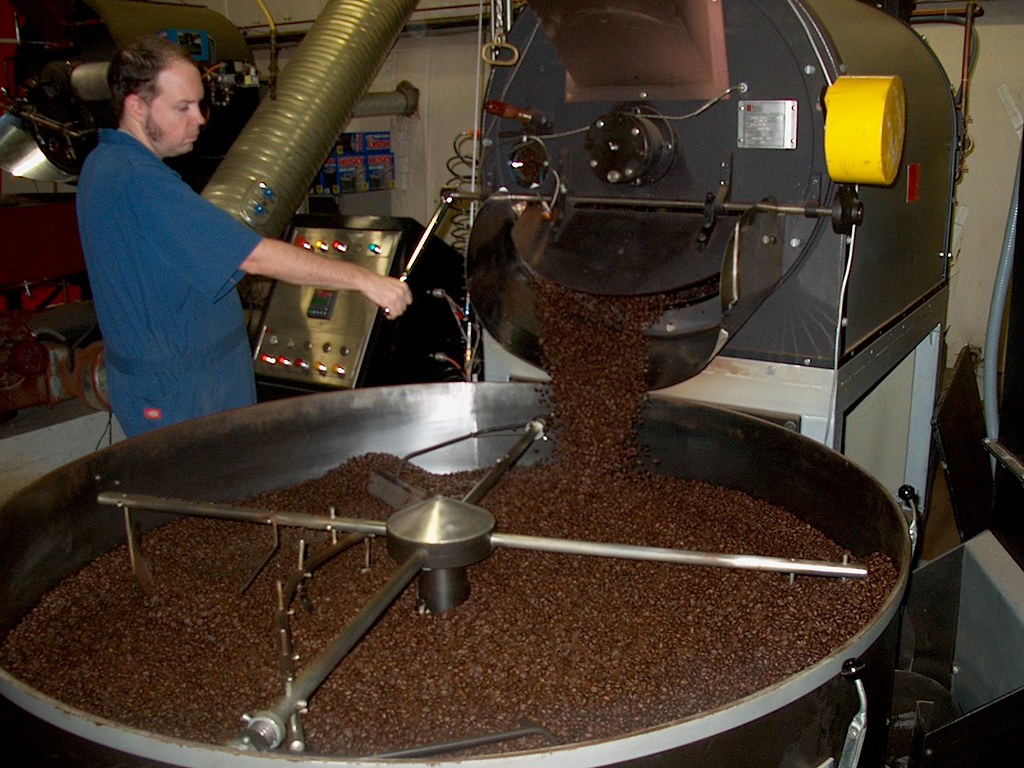
Read this blog entry for some insight into the Roaster/Barista relationship, and think about how you can contribute to the growing knowledge of coffee and espresso. It has been a fortnight or two since the Americans threw away all that perfectly good tea, only to replace it with a beverage so completly misterious that it's proper preparation remains an enigma, wrapped in a parchment, embeded in a cherry. The bean, like an onion, continues to reveal layer after layer of new flavors, nuances, techniques, tehchnologies, as well as myths and missinformation. Let us not peel on our own, but join together in the fight against blackend beans, big gulp beverages, and high fructose concoctions. Now, if you will excuse me, I feel like a nice tall glass of Lipton ice tea.


My infectious enthusiasm, effervescent passion, and constant hunger for new information and techniques related to coffee and it's preparation have translated into recognition from the Boss man. I work part time at a coffee shop owned by someone who's main occupation as an investment banker keeps him at a arm's length from the day to day goings on of his retail venture. As a coffee enthusiast, he wants the shop to produce top quality, but he dosen't have the time or energy to be the one to spread the right attitude amoung the workers himself. Lucky for him I came along, attracted by the quality of the source beans they use, and a ever-present need to handle a portafilter and pull shots on commercial equipment. After six months on the job, working only Friday nights, I have had the position of "Director of Coffee Operations" (or some such or other title) created for me.
Among my new duties include Barista training of all new employees (and well as refresher training of veteran Baristas), creation and implementation of all coffee making and drink building standards for the shop, and customer education of all aspects of coffee from the donkey to the demi-tasse. I have a very clear vision of what I believe the shop could be doing, and a crystal clear path laid out to get it there. If any lesson of life stands out for me at this point, however, it is to be ready for any possible twists, turns, and forks in the road. This challenge I will meet with the zeal and fervor required to accomplish any idealogical objective.
For all you small batch roasters of fine coffees sourced from the best places and best farmers on the planet, keep an open ear for my order of small quantities of your exotic and delicious product. I will be featuring the top beans from the best roasters to suppliment our inventory, and to educate the local coffee drinking public. I hope to expand the exprerience of enough customers to raise the bar for other shops in the area, and raise the standards and expectations of the market.
Now if you'll excuse me, I need to put a fresh blade in the hack saw, and bolt the grinder on to the work bench. Our portafilters have a little too much crotch.
P.S. I just put the photos up because I like to keep the blog visually stimulating.
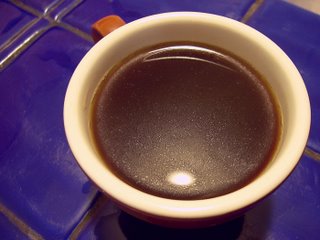

Peter Giuliano, Counter Culture's director of coffee, met a coffee farmer named Bagersh while traveling int the Yirgacheffe region of Ethiopia. It seems Bagersh had a little experiment going on, whereby he was sun-drying some beans, in the ancient Yirgacheffe tradition. This is only unusual in light of the fact that all coffees from that renown region have been washed ever since 1958. So the sun-dried product is a bit of a technological regression, even though one could say that is how it has always been done. The 48 years of washing beans is just a drop in the bucket when you take in the big picture. However, the clean, lemony, bright floral characteristics we associate with Yrigacheffes is all that we have in our living memory of these great coffees (I realize there are some senior coffee drinkers who may remember this style, please let us know if you are still out there). This throw-back flavor has an entirely different dimension, making it infinitely more complex than what we have gotten accustomed to. This is an amazing coffee that knocked me over from the moment I opened the bag.
(Edit: Bagersh is a coffee merchant, not a farmer, so I think he has contacts on farms who are drying the beans in the sun.)
My first impression, after recovering from my school girl swooning experience of the powerful cocoa and berry aroma, was that the beans were covered with some kind of powder. I thought it might just be the shadow of the bag in the bright Autumn sunlight creating a visual abnormality, but when I got them inside they still appeared strange. They look powdery gray, like they have been dusted with fine chalk, and the color has a light brown and dry matte quality. The size of the individual bean is very small, which is not unusual for Ethiopian coffee.
The flavor from the French press still has everything that I have come to expect from a Yirgacheffe. It was citrissy, with Jasmine flower accents, and had smooth and rounded body. There was also a dry mouthfeel while still seeming a little thick. But along with this was a powerful berry aromatic, like black and blue berries and some cherry. I thought there was a big chocolaty component, like cocoa powder. To drink it was almost like having a confection.
I want to finish the bag myself, but I suppose my co-workers at the coffee shop aught to have a taste, and my wife probably wants some too. One fellow Barista is actually waiting to brew his pound of it till he finds a grinder he likes.
Please send in those pictures of Soy latte art, read here for the prized you could win if you've got the right stuff.
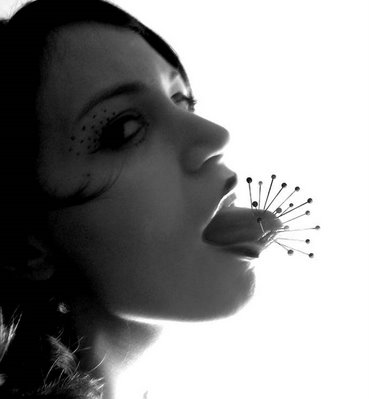
This is not meant to enhace your coffee enjoyment.
She must have a potty mounth.
My mom always had a cushion that looked like a tomato, I don't think she ever tried it like this.
I just thought you needed to see this.
You can find the rest of her pics here.

For those who have been here before, I have changed the look of the page, because I thought the other one looked too much like Martha Stuwart's 1970 cigar room wallpaper.
And by the way, this is my fixed, but forever horny cat. His name is Nearly Normal Norman KneeHigh.


I have come to find out that I have been brewing coffee at home in an unusual way, although I never realized it was strange untill the other day. While using a Chemex brand brewing decantor, I developed a technique for using paper filter that are not Chemex type filters, and another technique that achieves a French Press type of flavor.
If you have ever seen a Chemex filter, you will know that you can not simply subsitute them with any old thing. They appear stupidly oversized to the uninitiated, because they aren not pleated , crimped, rippled, or otherwise designed to fit into a basket. These things are perfectly flat circular sheets of filter paper with a diameter of about 12" or 14" (I don't have one in front of me at the moment to measur). The top of the Chemex is an inverted cone with a radius to match the shape of the filter which has been folded in the proper "Chemex" fashion. One must fold it in half, then fold the semi circular half in half to create a pie wedge shape that is a 1/4 circle. Popping open from the curved end makes it flare out to form the cone, which is placed in the top of the Chemex. The paper must be stiff enough not to buckle and fall into the bottom of the "hour glass" when wet, and large enough to keep all the grounds and water from spilling over the top. I havn't held one of these things in my hands for some 13 years now.
About 14 years ago I got a set of Chemex decantors at a yard sale. They were old even then, maybe 10-15 years old already. My roomate at the time kept one of them, and I got to keep two, one small size and one family size. The smaller one has been smashed for a decade now, but the large one (it holds more that a "12 cup" Mr. Coffee pot) lives on. It has a large shard chipped out of the top cone, but there is enough left to hold filters.
The official paper filters are not a common grocery store item. I have never seen them in departments stores either. I have not checked Willima Sanoma, but their stuff is usually out of my price range anyhow. That is why I began to use a gold filter in conjuction with the Chemex. I do not know what brand my filter is, but it is some metalic mesh with a "golden" color. I picked it up at the supermarket next to the Millstone and 8 o'clock display for maybe $5.00. It is not a perfect cone, it is made to replace #4 filters in some brand of auto drip machine. For this reason it does not fit perfectly into the top of the Chemex, but as long as one point of the gold filter is Keyed into the pouring slot it is quite suitable.
Using one of two methods, (please refer to the photo montage) I can replicate the flavor profiles of either the traditional Chemex method or the French Press. These are the two brewing methods most used by coffee roaster and coffee industry specialist. There are a couple of other unique decantor types, but the brewing principals are the same. The paper filter hold back certain coffee oils, and when the right temperature and brewing taboos are observed, one can make a clear, sweet, smooth, low acid coffee with a silky mouthfeel. The French Press allows these oils to pass through the wire mesh which brings out subtle floral or fruity notes, big birghtness in the acidity, and lets the beans shine with all their might. It also gives me heart burn and always has a muddy residue that settles to the bottom of the cup. The trick is to allow the particulate matter to settle by handeling the cup very gently and allowing only the most necessarry disturbances of the brew. The heart burn is something I am more than happy to put up with.
For the Traditional Chemex flavor I use a typical ruffled melita paper basket filter (my wife got a BJ's membership and came home with a pack of 600). I flatten it and fold it in half. The I fold in the two corners from a point off center to replicate the basic shape of a #4. Of course, you could just use a #4 filter, but that wouldn't be a cool technique specially devised by yours truely. At this point, just follow proper cone filter etiquette and your dreamy Prince Charming will take you to the ball.
To achieve the French Press flavor, simply omit the paper. Using the correct grind for my mesh filter, I place the appropriate amout of grounds in the filter and ad just enough hot filtered water to soak all the grounds without dripping down into the bottom of the hour glass. I wait plus or minus two minutes for the bloom, depending on the coffee, before adding the rest of the water, which is waiting on a heat source. This gives them time to expand as they take in moisture, and give off a lot of CO2, which is copiously expelled and inflates the bed of grounds like a pregnant lady. This is where it gets tricky, and I concentrate on three things here as I pour the remaining water:
1- Don't soak any part of the grounds more or less than any other part.
2- Don't pour the water directly through the side of the screen or it will pass without steeping any grounds.
3- Don't float the gournds by pouring fast or they will stick to the sides as the water level falls, leaving unsteeped grounds high and dry.
I think it is also important at this stage to time it so that the ground are not in contact with the water for more than four minutes from the first drop till the point when all the water has passed through the grounds. The result is a slightly cloudy brew with briliant and full flavor, like you might expect from a great French Press. All of this is assuming you are using very freshly ground coffee, very good quality beans, and an expertly roasted product. Obviously you don't need the Chemex to do this; you could place the gold filter in the top on any container you want your coffee to flow into. This includes but is not limited to: your cup, another brand of glass decantor, a thurmos bottle, some glass slipper you picked up at the ball. So long as the thing doesn't fall off the top or tilt over you are good to go.
I am not any sort of expert, master, or guru on the subject, as such, but simply some guy with an old beat up jar who happens to live close by to one the best roasting companies in the world. The coffee used in the photos is an organic Bolivian coffee from Counter Culture, and it was roasted about 28 hours before this brewing. I hope you enjoy similar results in your cup.

